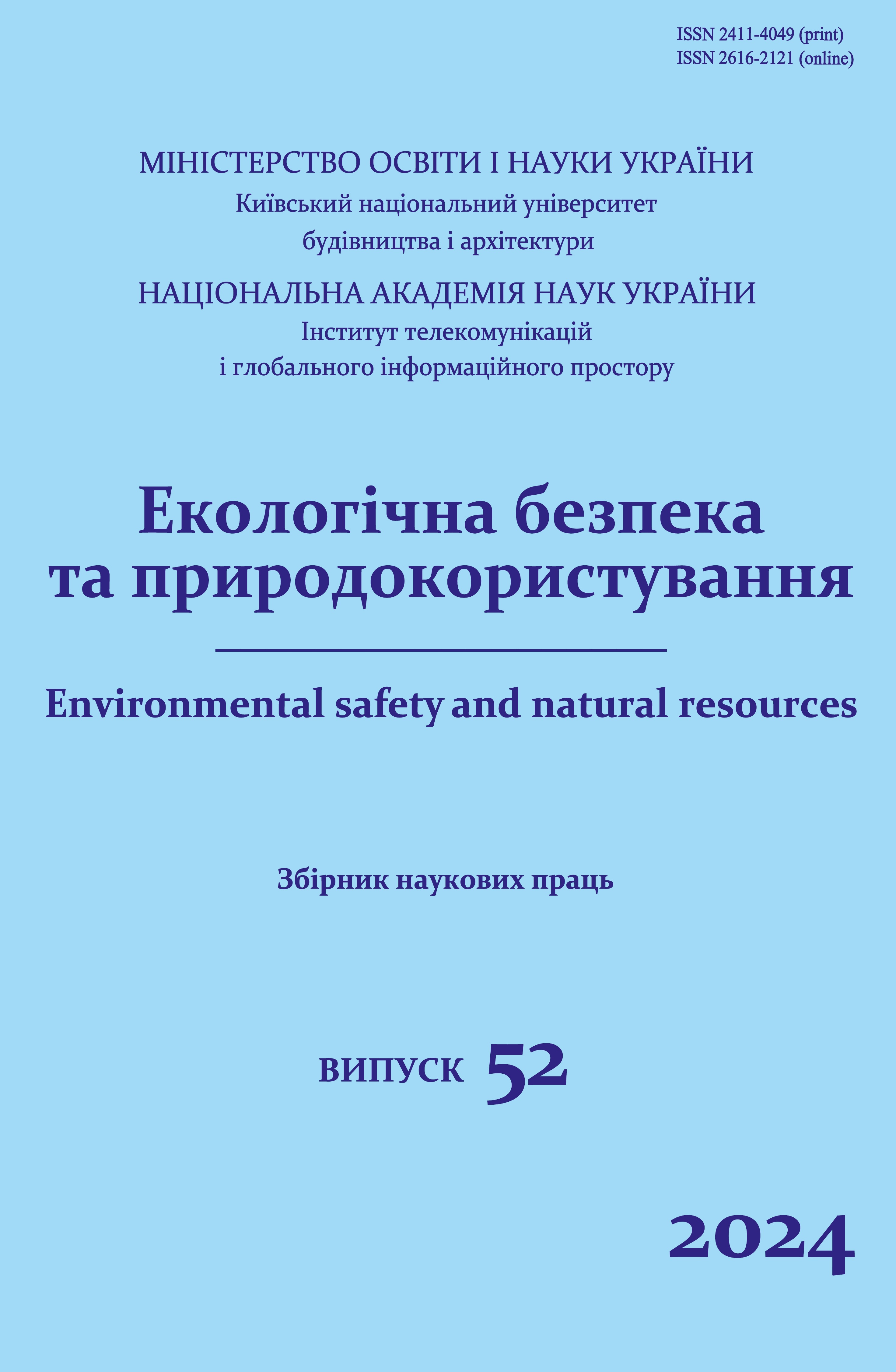Modeling of fine dust distribution in atmospheric air within residential buildings
DOI:
https://doi.org/10.32347/2411-4049.2024.4.69-80Keywords:
finely dispersed cement dust, neutralization, trapping, environmental safety, air quality monitoringAbstract
Sustainable development of the country includes a balance between economic growth, social welfare and environmental safety. This means managing all aspects of life so as to ensure the well-being of people and not harm the environment. This is important so that future generations can live in safety. The quality of atmospheric air is of particular importance, as it has a direct impact on people's health. Cement industry is one of the first positions on the scale of emissions of harmful substances, including carbon dioxide (CO₂). In its structure, dust emissions from cement plants are considered mainly as aerodisperse systems. In these systems, the dispersed phase consists of solid particles (dust) or fine droplets, while the dispersed phase is a gas-air mixture This gas-air mixture may contain a variety of contaminants, both organic and inorganic. Predicting and regulating air quality in areas adjacent to cement plants can be achieved by modeling the spread of cement dust. This simulation allows to determine dust concentrations in the air at different distances from the source of emissions and helps to develop effective measures to reduce the man-made load on the environment.
Cement dust is one of the priority pollutants that must be considered when organizing air quality monitoring. Effective atmospheric monitoring of dust pollution of the air environment allows you to obtain up-to-date data on dust concentration, analyze trends of change and assess the impact on human health and the environment.
Reducing the technogenic impact of aerodisperse systems formed as a result of cement production is an important task to ensure environmental safety.
We conducted a detailed analysis of the literary data of this problem and developed a mathematical model for predicting the distribution of cement dust in residential buildings. Invention proposes improvement of dust-collecting equipment in cement production that allows to reduce emissions of cement dust into atmosphere by 10-15%.
References
World Health Organization. (2020). Ambient air pollution: Health impacts. Retrieved from https://www.who.int/airpollution/ambient/health-impacts/ru/ (accessed 12 March 2020).
Turos, O.I., Petrosian, A.A., & Mykhina, L.I. (2011). Air hygiene: Experience and prospects of scientific support of problems of hygienic science and practice (pp. 133–149). Kyiv. (accessed 12 March 2020).
World Health Organization. (2013). Review of evidence on health aspects of air pollution – REVIHAAP: technical report. Copenhagen: WHO Regional Office for Europe, 302 p.
World Health Organization. (2006). Air quality guidelines – global update 2005. Copenhagen: WHO Regional Office for Europe.
European Union. (2008). Directive 2008/50/EC of the European Parliament and of the Council of 21 May 2008 on Ambient Air Quality and Cleaner Air for Europe. Official Journal of the European Union, Vol. 51, L 152, 44 p.
Janssen, N., & Mehta, S. (2006). Human exposure to air pollution. In Air quality guidelines for Europe (pp. 61-85). World Health Organization.
Cimorelli, A.J., Perry, S.G., Venkatram, A., Weil, J.C., Paine, R.J., et al. (2004). AERMOD: Description of Model Formulation, EPA-454/R-03-004. U.S. Environmental Protection Agency, 92 p. Retrieved from https://www3.epa.gov/scram001/7thconf/aermod/aermod_mfd.pdf (accessed 9 April 2020).
Horiachev, G., & Havryliuk, M. (2020). Modeling the spread of pollutants in the air using GIS technologies according to the OND-86 method. Scientific works of Vinnitsa National Technical University, 3, 1. Retrieved from https://trudy.vntu.edu.ua/index.php/trudy/article/view/157 (accessed 10 May 2020).
Cheliadyn, L.I. (2011). Scientific principles of resource-saving technologies and equipment to improve the environmental safety of industrial facilities in the Prykarpattia region: Doctoral dissertation. Ivano-Frankivsk, 340 p.
Bakharev, V.S. (2005). Environmental safety of the region under conditions of technogenic dust pollution of atmospheric air: Ph.D. thesis. Kremenchuk, 179 p.
Mokin, V.B., & Varchuk, I.V. (2013). Modeling the spread of pollutants in the air of a city using geoinformation technologies. Bulletin of Vinnytsia Polytechnic Institute, (5), 13-18.
Pliatsuk, L.D., & Hurets, L.L. (2016). Improving air quality based on managing the environmental safety of an industrial enterprise. Sciences of Europe, 1(3), 62-66.
Bondar, A.G., & Statyukha, G.A. (1976). Experimental design in chemical technology. Kyiv: Vyshcha Shkola.
Alentum Software, Inc. (2009). Advanced Grapher 2.2. Retrieved from http://www.alentum.com/agrapher/
MVV No. 081/12-0161-05. (2005). Industrial gas-dust emissions. Methodology for measuring the mass concentration of substances in the form of suspended solid particles in organized emissions from stationary sources by gravimetric method. Kyiv.
Koziy, I.S., & Hurets, L.L. (2009). The use of wet dust collection devices in the production of titanium dioxide. In Proceedings of the V International Jubilee Scientific and Practical Conference "Ecology. Economy. Energy Saving" (Sumy, 14-16 May 2009) (p. 39).
Polutrenko, M.S., & Paranyak, N.M. (2015). Improving the efficiency of dust collection systems using developed modified devices. Interuniversity collection "Scientific Notes", 52, 54-59. Lutsk.
Dust Collection System: Patent 155139 Ukraine: B01D 29/00, B01D 46/02. I.M. Petrushka, N.V. Latsyk, M.P. Kulyk. No u 2022 02724; applied on 24.08.2023; published on 24.01.2024; Bulletin No. 4. Retrieved from https://base.uipv.org/searchInvStat/showclaimdetails.php?IdClaim=349406&resId=1
Serebryanskyi, D.O., Plashykhin, S.V., Beznosyk, Yu.O., & Nabok, O.M. (2014). Mathematical modeling of dust-laden gas flow cleaning in a cyclone dust collector. Eastern-European Journal of Enterprise Technologies, 2(10(68)), 11–16. https://doi.org/10.15587/1729-4061.2014.23351
Babkov, V.S., & Tkachenko, T.Yu. (2011). Analysis of mathematical models of pollutant dispersion from point sources. Scientific Works of DonNTU, 13(185), 147–155.
Downloads
Published
How to Cite
Issue
Section
License
Copyright (c) 2024 I.M. Petrushka, N.V. Latsyk, K.I. Petrushka

This work is licensed under a Creative Commons Attribution 4.0 International License.
The journal «Environmental safety and natural resources» works under Creative Commons Attribution 4.0 International (CC BY 4.0).
The licensing policy is compatible with the overwhelming majority of open access and archiving policies.

